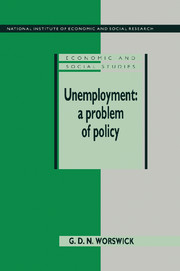Book contents
- Frontmatter
- Contents
- List of tables
- List of charts
- Preface
- 1 INTRODUCTION
- 2 CONCEPTS AND MEASUREMENTS
- PART 1 STRUCTURAL CHANGE
- 3 TECHNOLOGY AND EMPLOYMENT
- 4 THE IMPACT OF INFORMATION TECHNOLOGY
- 5 STRUCTURAL UNEMPLOYMENT
- 6 THE REGIONAL PROBLEM
- 7 WHO WILL PROVIDE THE JOBS?
- PART 2 THE WAGE QUESTION
- PART 3 MACROECONOMIC POLICY
- PART 4 INTERNATIONAL DIMENSION
- Appendix to Chapter 8: The puzzle of the apparent fall in United States real wages
- Notes
- List of works cited
- Index
- THE NATIONAL INSTITUTE OF ECONOMIC AND SOCIAL RESEARCH PUBLICATIONS IN PRINT
4 - THE IMPACT OF INFORMATION TECHNOLOGY
from PART 1 - STRUCTURAL CHANGE
Published online by Cambridge University Press: 06 July 2010
- Frontmatter
- Contents
- List of tables
- List of charts
- Preface
- 1 INTRODUCTION
- 2 CONCEPTS AND MEASUREMENTS
- PART 1 STRUCTURAL CHANGE
- 3 TECHNOLOGY AND EMPLOYMENT
- 4 THE IMPACT OF INFORMATION TECHNOLOGY
- 5 STRUCTURAL UNEMPLOYMENT
- 6 THE REGIONAL PROBLEM
- 7 WHO WILL PROVIDE THE JOBS?
- PART 2 THE WAGE QUESTION
- PART 3 MACROECONOMIC POLICY
- PART 4 INTERNATIONAL DIMENSION
- Appendix to Chapter 8: The puzzle of the apparent fall in United States real wages
- Notes
- List of works cited
- Index
- THE NATIONAL INSTITUTE OF ECONOMIC AND SOCIAL RESEARCH PUBLICATIONS IN PRINT
Summary
Most of the evidence concerning technical change, which we have considered up to now, has been indirect, as well as aggregative, being statistics for labour productivity or total factor productivity, for the whole economy, or substantial sectors of it such as manufacturing. We concluded that the rise in unemployment in the advanced countries in the 1970s and 1980s could not be laid at the door of any speeding up of technical change, but we admit to being uneasy that we may have missed something, somewhere. After all, individual cases of spectacular replacements of labour by computers and computer controlled machinery seem to be reported in the newspapers almost daily. The social scientist should, of course, be wary of anecdotal evidence – but when there are so many anecdotes one begins to wonder. Moreover, as Leontief has remarked, even on the assumption of an accelerated introduction of computers, the information technology (IT) revolution will still be in its early stages at the turn of the century, at the level say of 1820 in the history of the industrial revolution.
Direct information about the speed with which IT is being introduced, and the effect it is having on employment and unemployment in particular cases can be obtained from surveys of firms – and a variety of such surveys have been undertaken in recent years. They have included questions, not only about the extent of IT introduction already reached, but about plans for the future, as well as questions on the attitude of the workers directly affected by the new methods.
- Type
- Chapter
- Information
- Unemployment: A Problem of PolicyAnalysis of British Experience and Prospects, pp. 33 - 40Publisher: Cambridge University PressPrint publication year: 1991

